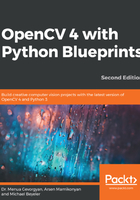
Applying morphological closing for smoothening
A common problem with segmentation is that a hard threshold typically results in small imperfections (that is, holes, as in the preceding image) in the segmented region. These holes can be alleviated by using morphological opening and closing. When it is opened, it removes small objects from the foreground (assuming that the objects are bright on a dark foreground), whereas closing removes small holes (dark regions).
This means that we can get rid of the small black regions in our mask by applying morphological closing (dilation followed by erosion) with a small 3 x 3-pixel kernel, as follows:
kernel = np.ones((3, 3), np.uint8)
frame = cv2.morphologyEx(frame, cv2.MORPH_CLOSE, kernel)
The result looks a lot smoother, as follows:

Notice, however, that the mask still contains regions that do not belong to the hand or arm, such as what appears to be one of the knees on the left and some furniture on the right. These objects just happen to be on the same depth layer of my arm and hand. If possible, we could now combine the depth information with another descriptor, maybe a texture- or skeleton-based hand classifier that would weed out all non-skin regions.
An easier approach is to realize that most of the time, hands are not connected to knees or furniture. Let's learn how to find connected components in a segmentation mask.